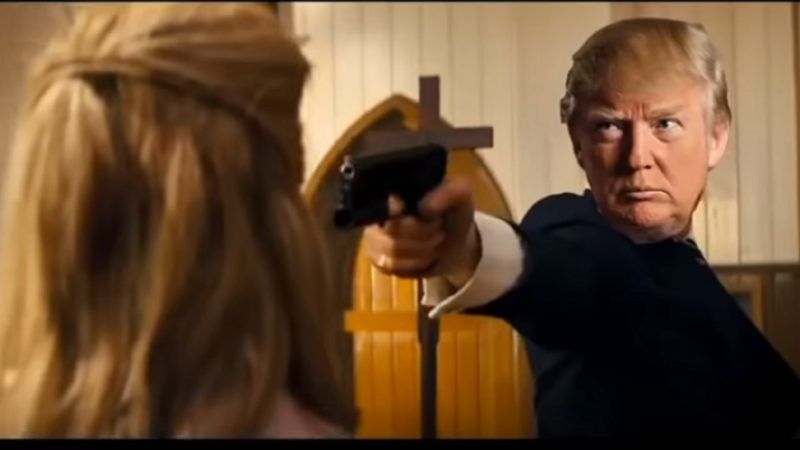The New York Times, NBC, and Other Outlets Don't Trust You To Handle the Truth
The mainstream media are channeling Dr. Zaius, the elitist orangutan from Planet of the Apes, who hid dark secrets out of misguided paternalism.

In the original Planet of the Apes movie (1968), the most-fascinating character is Dr. Zaius, the elitist, orangutan in chief who alone possessed the secret knowledge that (spoiler alert!) apes descended from humans. Toward the end of the film—shortly before he warns Charlton Heston's character not to search for the truth "because you may not like what you find!"—he monologues that the hoi polloi (chimps and gorillas in this case) must be shielded from certain realities lest they be driven to insanity and nihilism.
The legacy media are having their Dr. Zaius moment, paternalistically shielding their infantile audience (read: you and me) from ugly images and realities. This is not simply a revolting development but a deeply troubling one that will only accelerate the ongoing loss of confidence and trust the public has in media. According to polling done for the Columbia Journalism Review, fewer than 20 percent of us have a "great deal of confidence" in the press. The only institution held in lower esteem is Congress.
Yet the media seem happy to keep digging their own grave. Yesterday, for instance, The New York Times reported on what it called a "macabre video of [a] fake Trump shooting media and critics" that was shown at a conference held at one of the president's own properties (Trump had nothing to do with the conference or the video, which the White House has condemned). You'd assume the paper would link to or embed the video in support of its characterization. But it refused to, even as it's safe to say that it was the Times' coverage that helped bring the video to a large viewing audience (that's how I learned about it). Instead, it described the video, which was included in an exhibition of videos associated with pro-Trump "memesmith" Carpe Donktum, thus:
The video, which includes the logo for Mr. Trump's 2020 re-election campaign, comprises a series of internet memes. The most violent clip shows Mr. Trump's head superimposed on the body of a man opening fire inside the "Church of Fake News" on parishioners who have the faces of his critics or the logos of media organizations superimposed on their bodies. It appears to be an edited scene of a church massacre from the 2014 dark comedy film "Kingsman: The Secret Service."
Here's the video that the Times was quick to write about but refused to link to in its online coverage (forget about embedding!). Decide for yourself is this is too much for regular folks to handle:
The video, which was originally posted to YouTube over a year ago, had virtually no views until the Times' coverage; as of this writing, it had more than 136,000 views on the channel above and has been viewed millions more times in various YouTube and Twitter iterations. The Times' leadership seems more than willing to grab readers' eyeballs by talking about the video, but they are not willing to provide readers with easy access to the offending material.
A similar mindset seems at work behind the producers of Meet the Press, who "in good conscience" refused to show footage from a recent presidential rally that they nonetheless had no qualms about condemning from a moral point of view:
WATCH: The president held a campaign rally last night and attacked Hunter Biden. We cannot in good conscience show it to you @chucktodd: "Politics ain't beanbag, but it isn't supposed to be this either. We all need to play a role in not rewarding this kind of politics" pic.twitter.com/ERPk4SJ0Yf
— Meet the Press (@MeetThePress) October 11, 2019
Here's one version of relevant passages from the rally, in which the president lays into former Vice President Joe Biden and his son Hunter (this starts around the two-minute mark). Trump's rhetorical question, "Where's Hunter?" even started trending on Twitter in the wake of this.
It's ugly stuff, to be sure, but that's exactly why the press should not be reticent both in covering controversial speech and providing access to it. That's the best way for the audience to agree with any given outlet's analysis, assuming it is accurate and truly persuasive. Instead, the press is choosing to become passive-aggressive, effectively saying, "Here's a really disturbing important thing that X just did, but we're not going to let you judge for yourself." That's what the New Zealand media did after the Christchurch mass shooting this year. In the name of fighting "extremism," the government banned owning or sharing the shooter's manifesto, which was a disgusting piece of incoherent white supremacist garbage. Amazingly, the New Zealand media voluntarily censored its own coverage of the event, the shooter, and judicial procedures—and drew praise from American journalists for such actions.
The actions of the Times, Meet the Press, and the New Zealand media will not slow the loss of confidence and trust in the media. On the contrary, such behavior will accelerate it as readers continue to rebel against such paternalism by searching out alternative sources of information (including many shady, conspiracist sites). There's already a widespread belief, some or much it justified, that powerful elites hold most Americans in various forms of contempt. Simultaneously telling those same readers, viewers, and listeners that big, important, scary things are happening and then withholding primary sources is a perfect recipe to increase cynicism and anger toward the media.
Paternalism didn't work for Dr. Zaius (what kind of doctor was he, anyway?) and it's even less likely to work for the solons overseeing the decline of empires of print, cable, and other forms of legacy media. They should trust their readership and give them more information, not less, when it comes to the news of the day.


Show Comments (185)